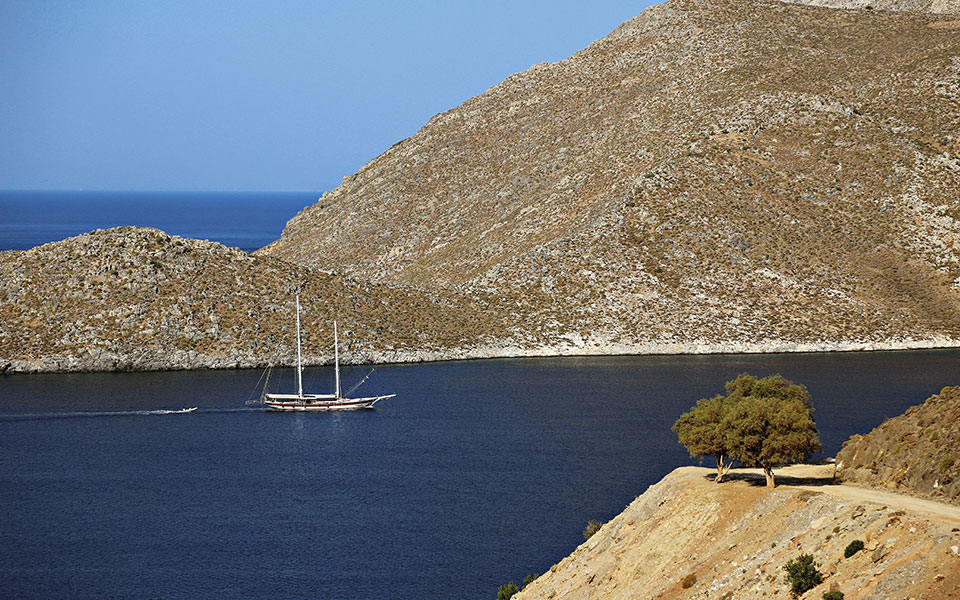There is a corner, the southeast corner of the Aegean, that isn’t crossed by the more popular routes traversing this sea. Between the eastern end of Crete and the southwestern end of Rhodes, there are a number of islands whose names are not part of the usual litany of destinations you hear from those who sail in this area. These islands are Halki, Tilos, Karpathos and Kasos, and they form an enchanting island bridge between Rhodes and Crete.
I first cruised around here in 1980, heading northeast from Crete towards Rhodes while researching the first edition of Greek Waters Pilot, a cruising guide to the Ionian and Aegean coasts and islands. It was spring, and I’d left early in the morning from a wild rockbound anchorage tucked under Cape Sidero on the northeast tip of Crete. The passage to the large bay of Helatronas on the bottom of Kasos was relatively easy, with light winds from the north which meant I was hard on the wind but comfortable enough. I was happy the wind gods had been lenient as I dropped anchor on a lovely sand bottom in the bay.
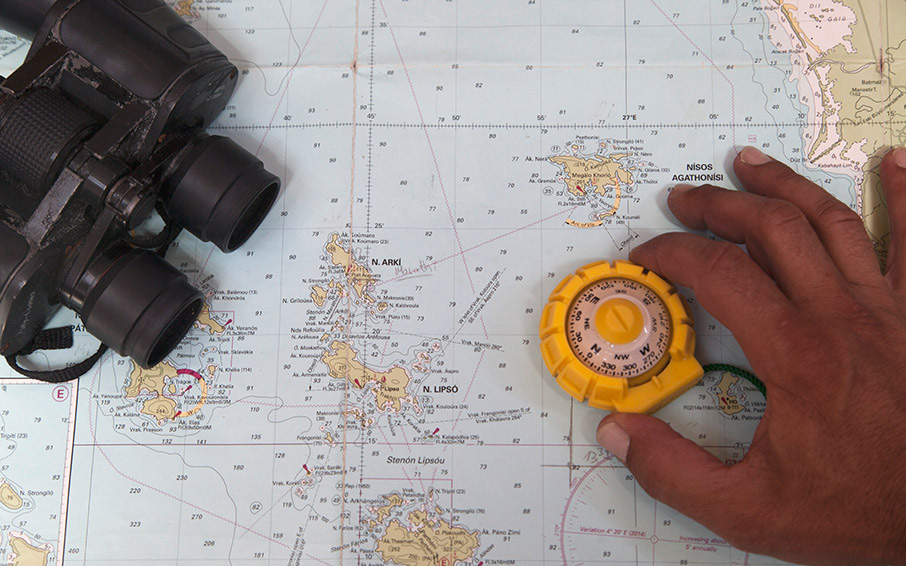
© Olga Charami
Sitting in the cockpit with a cup of tea, I glanced up at the cliffs surrounding the bay and then had to take a second look. There were people all around the cliff-top. I got out the binoculars for a better look and found they were, in fact, scarecrow-type figures. Why? And why so many? The more I looked, the more unnerved I became.
It took a while for me to remember some local history I’d read. Kasos had been ravaged by the Egyptians in 1824, and most of the inhabitants had been killed or taken prisoner. The island was pillaged and the town destroyed. Kasos had declared independence early on in the Greek War of Independence, which started in 1821, and the Egyptians, who were aiding the Turks, decided to teach the island a lesson. From a population of 11,000, only a hundred or so survived. Perhaps the scarecrow figures on the cliff-top were there to give the impression that, this time, the Kasiots were ready and waiting for any invaders. I slept fitfully that night.
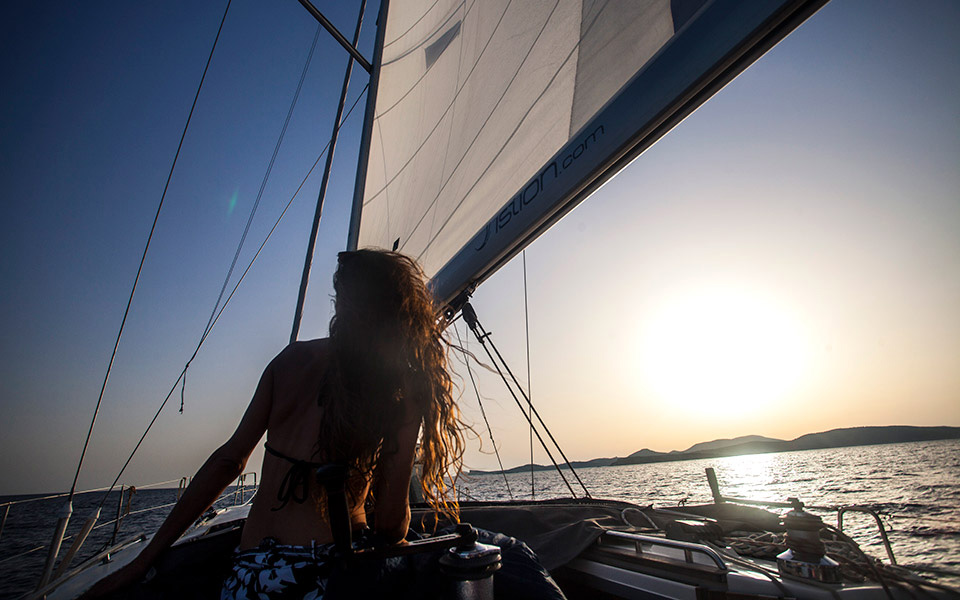
© Olga Charami
I spent a couple of weeks cruising around Kasos and Karpathos with nary another yacht in sight. In subsequent years, I’ve visited the islands again and it’s unusual to see more than another yacht or two around. At either end of the island bridge, around Rhodes and the eastern end of Crete, there are a few more yachts, but not many, with the exception of the main port of Rhodes. That might be because this is a windy old sea-tossed corner of the Aegean but, with some passage planning and attention to the weather, sailing this area is eminently manageable; what’s more, it’s like stepping back in time to 20 years ago.
Another part of the Dodecanese, further north, presents a slightly different experience; it is our account of this section that follows.
6 Days at Sea
A trip around the Dodecanese is ideal for those who’d like to discover beautiful landscapes, tiny islets and sites whose historical importance spans the centuries.
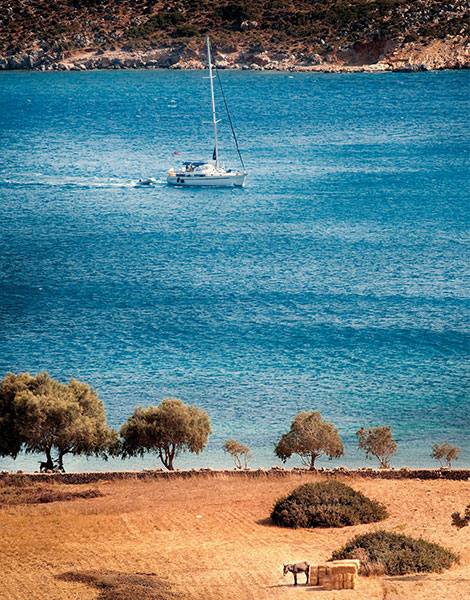
© Alamy/Visualhellas.gr
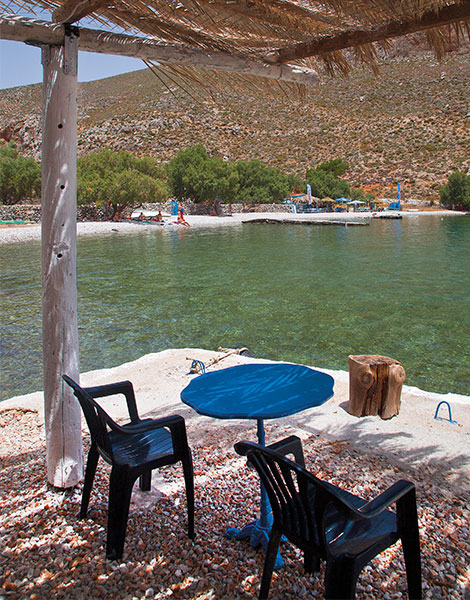
© Olga Charami
Day One
Kos to Kalymnos (15 miles)
Once clear of the marina at Kos, you’ll need to plot a course to clear the shoal waters extending off the shore at Ammoglossa on the northern tip of Kos before shaping a course around Pserimos. The main harbor of Kalymnos is on the south coast of the island, and the many houses climbing up the hill make identifying the town easy. Kalymnos is known as the center for sponge diving in the Mediterranean, and as a rock-climbing paradise.
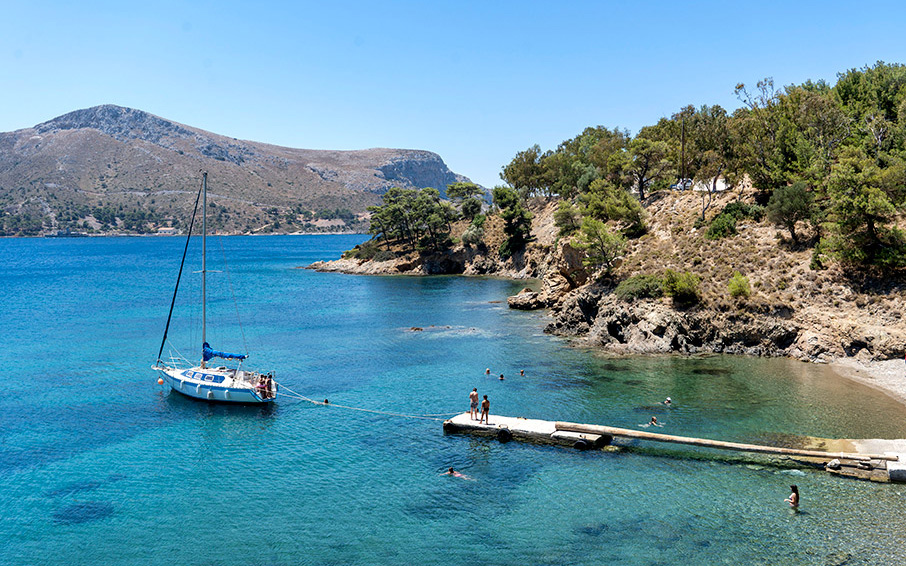
© Perikles Merakos
Day Two
Kalymnos to Leros (20 miles)
It’s likely to be a bit of a windward bash if the meltemi is blowing. An early start should allow you to make some easy miles before the wind really kicks up. The east coast of Kalymnos is wild and mountainous, and depths drop off quickly, with no dangers to navigation. Head through Steno Leros, keeping to the main channel, before heading up into Lakki Bay. Lakki Marina lies on the western edge of the town, while Marina Leros sits in the NE corner of the bay.
The town of Lakki could be the Art Deco capital of Greece: the buildings around the bay all date from the Italian occupation, when it was an important naval base. The buildings are arranged along wide boulevards, and include a superb market and shopping arcade with covered walkways and a circular atrium; a cinema with a fine curved façade; the old Leros Palace Hotel; and large Art Deco villas scattered among newer concrete buildings.
There are numerous tavernas along the waterfront and in town. The restaurant Lyxnari has an imaginative Greek menu but you’ll have to book in advance. The same holds true for Taverna Petrino near the post office in town, but it’s worth it – the owner is a butcher, and when it comes to meat, he knows his stuff.
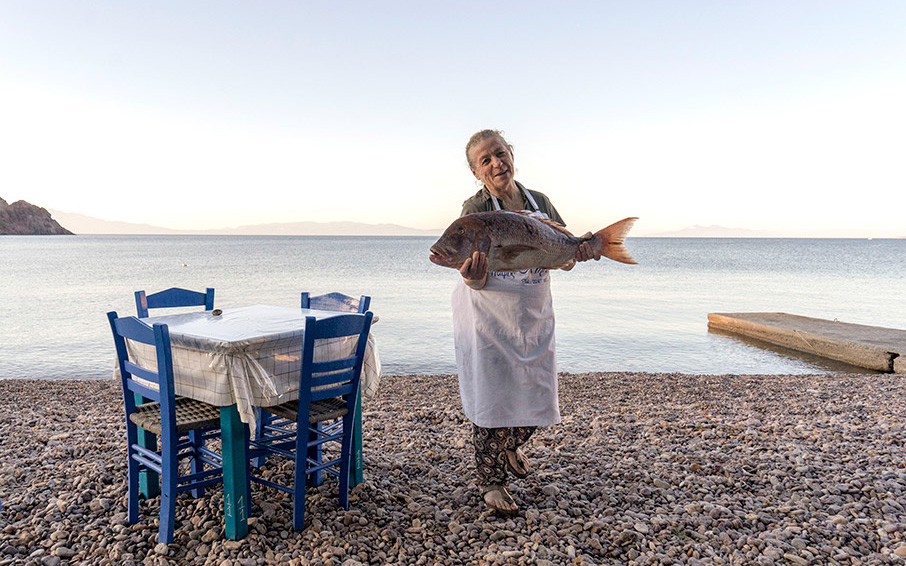
© Perikles Merakos
Day Three
Leros to Patmos (19 miles)
This run is another windward leg on your journey but, again, an early start will get some easy miles in. You’ll need to keep an eye out for islets and reefs in the approaches to Patmos. Once into the harbor at Skala, head up past the cruise ship and ferry quays to the NW corner. Patmos is second only to Mt Athos as the spiritual center of Greek Orthodoxy. The well-fortified Monastery of St John sits on the hill behind Skala on the road to Patmos Town and is open to visitors. Below it is the Cave of the Revelation where, according to legend, St John transmitted the fiery words of God, found today in the book of Revelations, to his disciple and scribe Prochoros.
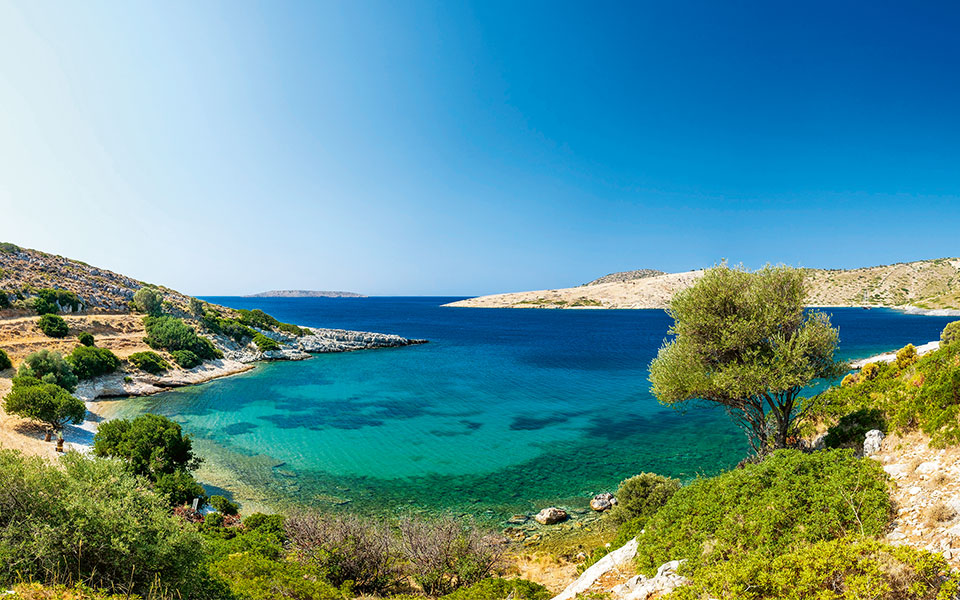
Day Four
Patmos to Agathonisi (21 miles)
This route takes you through the islets around the Arki Islands and, depending on the strength of the meltemi, you can explore them, but care is needed as few charts show all the dangers and eyeball navigation is a must. A favorite stop of ours is the bay on the east side of Marathos – pick up a buoy and head in for an early lunch at one of the tavernas here. Agathonisi is a true gem, sitting out on its own off the Turkish coast, exiled by windswept seas and the fact it’s not really on the way to anywhere.
The locals (there are about 150 of them) rely on farming and fishing, and by making a little cash from the mostly yacht-borne tourists who come out this far. Aghios Georgios is the main harbor, and there’s good shelter there from the meltemi, albeit with gusts blowing down the valley. The best thing to do is to anchor with a long line to the posts set into the rocky shelf at the head of the bay. This bay and the small hamlet on its shore are special places, geographically and spiritually removed from the larger islands. There is nothing you need to do here – maybe a swim, maybe a walk up to Megalo Horio, the main village of the island, which lies inland, tucked into a fold in the hills over the ridge behind the harbor.
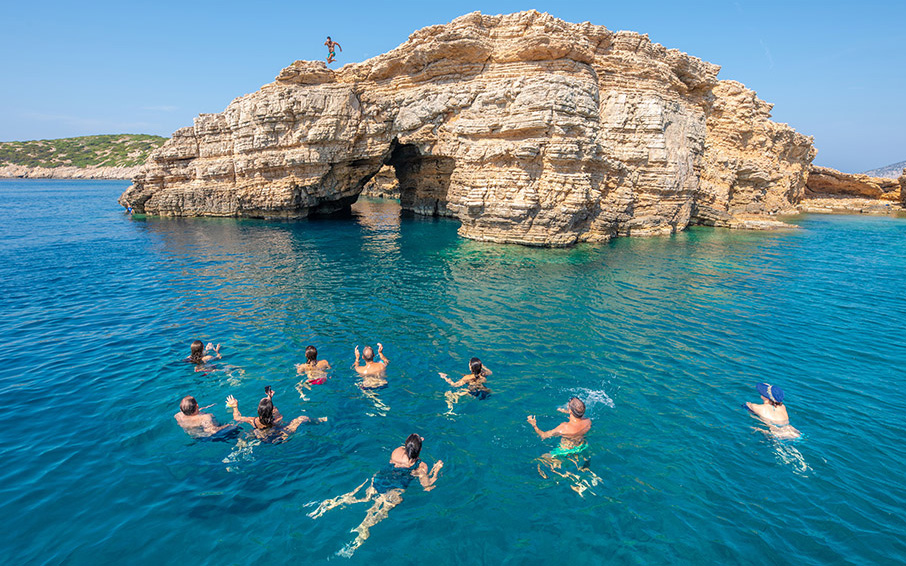
© Giorgos Vergados, Instagram: @vergadosg
Day Five
Agathonisi to Lipsi (21 miles)
The islets and reefs of Vrak Kouloura on the SE tip of Lipsi shouldn’t be approached as they aren’t marked and it’s difficult to identify them with any sea running. On the other hand, the waters around the islets and reefs of Vrak Khalavra, just outside Lipsi Bay, are enchanting – more reminiscent of the Bahamas than the Aegean. In calm weather, it’s well worth stopping here for a swim before you head into Lipsi Bay, where there are yacht berths on the pier. The ouzeries around the harbor are the perfect place to start your evening, before you wander up the hill, towards the church, to where there are a number of good tavernas.
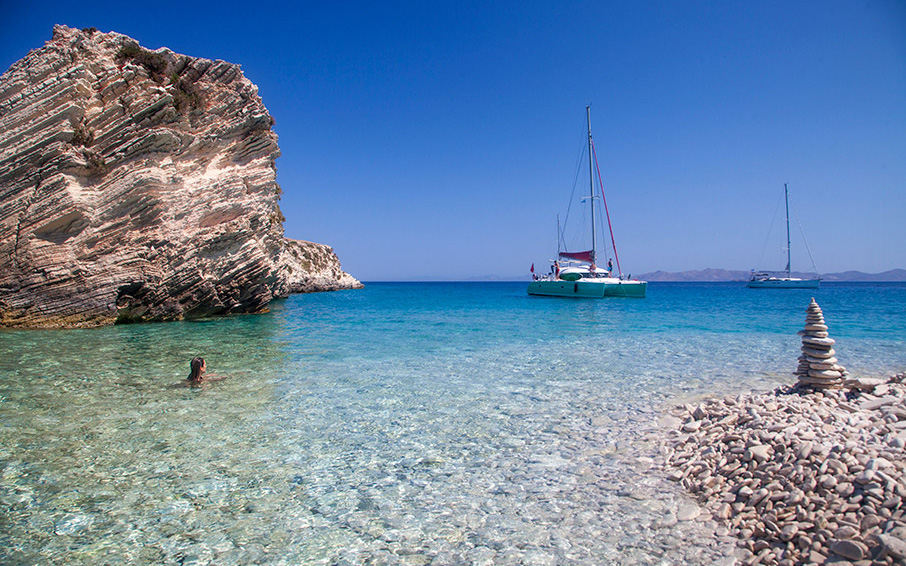
© Olga Charami
Day Six
Leipsoi to Kos (33 miles)
Under normal circumstances, this should be a fine downwind sail. Once out of Lipsi Bay, head southeast and sail down the east coast of Leros and Kalymnos. On the final leg home, you’ll need to remember the shallows off the north tip of Kos.
From the marina, it’s a long hot walk along the hotel-lined waterfront into the old town which radiates out from the old harbor. The castle was built in 1431 by the Knights of St John, who held sway here (and in Rhodes) until they were ousted by Suleiman in 1522 and the island came under Ottoman rule. While Kos has something of a reputation for tourism of the rowdy kind, the old town retains much to recommend it. The colonnaded buildings date from the Italian occupation and are in a sort of monumental style with Art Deco additions. Sprinkled throughout the town are remnants of previous inhabitants: a couple of minarets, a hammam, a synagogue, the ancient ruins of the Asklepion and, believe it or not, the plane tree under which, it’s said, Hippocrates sat and taught his students.

